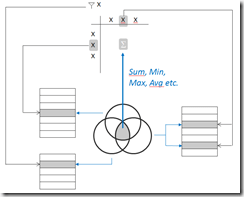Winner of Best BI Software for SQL. Get the Most out of Your Data. Watch the Free Tableau Video Demo! Move Forward With Confidence. Connecting With The Data Community.
Except for COUNT, aggregate functions ignore null values. Aggregate functions are often used with the GROUP BY clause of the SELECT statement. An SQL aggregate function calculates on a set of values and returns a single value.
For example, the average function (AVG) takes a list of values and returns the average. Because an aggregate function operates on a set of values, it is often used with the GROUP BY clause of the SELECT statement. An aggregate function performs a calculation one or more values and returns a single value. The functions themselves are the same ones you will find in Excel or any other analytics program.

These functions used mostly in real world industry examples. In following section i will give you syntax of aggregate function and real life use of aggregate function with explaining the example. We often use aggregate functions with the GROUP BY and HAVING clauses of the SELECT statement. SQL provides aggregate functions to help with the summarization of large volumes of data. This function can produce a single value for an entire group or table.
They operate on sets of rows and return based on groups of rows. SQL provides many inbuilt functions that are used for performing various operations in data. Aggregate Functions are used for performing operations on multiple rows of a particular column and result in a single value. Here is an example: The result of this will be the number 2. What is SQL aggregate function? Most functions in Oracle operate on a single row or single record – such as DECODE or LENGTH.
The MAX() aggregate function in SQL takes the name of a column as an argument and returns the largest value in a column. The given query will return the largest value from the amount column. The SUM aggregate is a function that operates on a collection of objects, and provides a single result per group. Red The most commonly used SQL aggregate function is the COUNT function.
The group is defined with the SQL construct GROUP BY and here that’s the album, so we get a SUM per album. They basically summarize the of a particular column of selected data. We are covering these here since they are required by the next topic, GROUP BY.
You can use these functions in a query and aggregate expressions in the SQL property of a QueryDef object or when creating a Recordset object based on an SQL query. It works on both numeric and non-numeric data types. All aggregate functions by default exclude nulls values before working on the data. Try the queries in a smaller subset of your data first to confirm that all calculations are working as expected.
The SQL Server SUM() function is an aggregate function that calculates the sum of all or distinct values in an expression. However, if the values are in multiple rows, you will need to use SQL aggregate functions. They are used for specific operations like to compute the Average of the numbers, Total Count of the records, Total sum of the numbers etc. These are also called Group functions because these functions apply to the group of data. A SQL statement that applies an aggregate function to a set of tuples with the goal of grouping them together, based on certain criteria to form a single value.
The aggregate function SQL MAX() is used to find the maximum value or highest value of a certain column or expression. The SQL COUNT function is an aggregate function that returns the number of rows returned by a query. You can use the COUNT function in the SELECT statement to get the number of employees, the number of employees in each department, the number of employees who hold a specific job, etc.
Nincsenek megjegyzések:
Megjegyzés küldése
Megjegyzés: Megjegyzéseket csak a blog tagjai írhatnak a blogba.